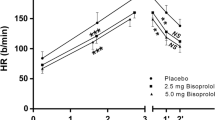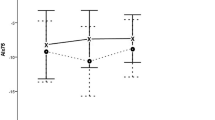Summary
Patients treated with beta-blocking agents often complain of fatigue during exercise. Exercise capacity is decreased under this condition. Nebivolol is a new beta1-adrenoceptor antagonist with a particular hemodynamic profile, which might be due to an ancillary property. Five milligrams once daily seems the optimal dose for antihypertensive treatment. In a double-blind, placebo-controlled crossover study, the effects of nebivolol on maximal and endurance exercise capacity are compared with those of atenolol in healthy volunteers. The hemodynamic and metabolic effects during exercise are also studied. Nebivolol 5 mg once daily and atenolol 100 mg once daily decrease blood pressure at rest similarly. At these dosages nebivolol shows a smaller decrease in heart rate than atenolol. During exercise, the rise in systolic blood pressure and heart rate is less depressed with nebivolol than with atenolol. In contrast to atenolol, nebivolol does not decrease maximal and endurance exercise capacity, and does not increase perceived exertion significantly. Changes in hemodynamics influence maximal exercise capacity. Since nebivolol has less effect on exercise hemodynamics than atenolol, this might explain why maximal work capacity is not changed during nebivolol. During endurance exercise metabolic effects are thought to be more important. Under nebivolol glycerol and NEFA production is less depressed during exercise and might explain the preserved endurance capacity. These data suggest less beta blockade during nebivolol than during atenolol at the dosages used in this study. In conclusion, at a dose known to be antihypertensive, nebivolol does not alter exercise capacity significantly in healthy volunteers.
Similar content being viewed by others
References
Franz I-W, Lohmann FW, Koch G. Effects of chronic antihypertensive treatment with acebutolol and pindolol on blood pressures, plasma catecholamines and oxygen uptake at rest and during submaximal and maximal exercise. J Cardiovasc Pharmacol 1982;4:180–186.
Smyth GA, Hughson RL, Walters DJ, Ranney DA. Short-versus long-term effects of oral beta-blockers on exercise performance. J Cardiac Rehab 1984;4:227–237.
Van Baak MA, Jennen W, Verstappen FTJ. Maximal aerobic power and blood pressure in normotensive subjects after acute and chronic administration of metoprolol. Eur J Clin Pharmacol 1985;28:143–148.
Szlacheic J, Hirsch AT, Tubau JF, et al. Diltiagem versus propranolol in essential hypertension: Responses of rest and exercise blood pressure and effects on exercise capacity. Am J Cardiol 1987;59:393–399.
Van Baak MA, Koene FMM, Verstappen FTJ. Exercise hemodynamics and maximal exercise capacity during beta-blockade in normotensive and hypertensive subjects. Br J Clin Pharmacol 1988;25:169–178.
Galbo H, Holst JJ, Christensen NJ, Hilsted J. Glucagon and plasma catecholamines during beta-receptor blockade in exercising man. J Appl Physiol 1976;40:855–863.
Lundborg P, Aström H, Bengtsson C, et al. Effect of beta-adrenoceptor blockade on exercise performance and metabolism. Clin Sci 1981;61:299–305.
Kullmer T, Kindermann W, Singer M. Effects on physical performance of intrinsic sympathicomimetic activity (ISA) during selective beta-blockade. Eur J Appl Physiol 1987; 56:292–298.
Van Baak MA, Böhm ROB, Arends BG, et al. Long-term antihypertensive therapy with beta-blockers: Submaximal exercise capacity and metabolic effects durign exercise. Int J Sports Med 1987;8:342–374.
Van Baak MA, Böhm ROB, Petri J, Rahn KH. Metabolic effects of verapamil and propranolol during submaximal endurance exercise in patients with essential hypertension. Int J Sports Med 1987;8:270–274.
Cléroux J, Van Nguyen P, Taylor AW, Leenen FHH. Effects of β1 vs β1 + β2 blockade on exercise endurance and on muscle metabolism in humans. J Appl Physiol 1989; 66:548–554.
Vanhees L, Fagard R, Lijnen P, Amery A. Effect of antihypertensive medication on endurance exercise capacity in sporting hypertensive patients. Fifth European Meeting on Hypertension, 1991; abstr no 752.
Sahlin K. Metabolic changes limiting muscle performance. In: Saltin B, ed. Biochemistry of exercise. VI. International series on sport sciences, vol 16. Champaign, IL: Human Kinetics, 1986;323–343.
Van de Water A, Janssens W, Van Nueten J, et al. Pharmacological and hemodynamic profile of nebivolol, a chemically novel, potent, and selective β1-adrenergic antagonist. J Cardiovasc Pharmacol 1988;11:552–563.
Schnaper H, Jackson D, Sit SP. Nebivolol: A new generation of β-blockers in hypertension. Am J Hypertens 1991;4:23A.
Sieben G, Van Nueten L, Symoens J. Nebivolol in hypertension. Drug Invest 1991;3(Suppl 1):190–192.
Sanchez RA, Cianciulli T, Dopico AM, et al. Effects of nebivolol on left ventricular function in patients with essential hypertension. Drug Invest 1991;3(Suppl 1):155–160.
Collier CR. Determination of mixed venous CO2 tensions by rebreathing. J Appl Physiol 1956;9:25–29.
Jones NL, Campbell EJM, McHardy GIR, et al. The estimation of carbon dioxide pressure of mixed venous blood during exercise. Clin Sci 1967;32:311–327.
van Herwaarden CLA, Binkhorst RA, Fennis JFM, Van't Laar A. Reliability of the cardiac output measurement with the indireet Fick principle for CO2 during exercise. Pflügers Arch 1980;385:21–23.
Inman MD, Hughson RL, Jones NL. Comparison of cardiac output during exercise by single breath and CO2 rebreathing methods. J Appl Physiol 1985;58:1372–1377.
Costill DL, Fink WJ. Plasma volume changes following exercise and thermal dehydration. J Appl Physiol 1974;37: 521–525.
Borg G. Perceived exertion as an indicator of somatic stress. Scand J Rehab Med 1970;2:92–98.
Duncombe MG. The colorimetric micro-determination of non-esterified fatty acids in plasma. Clin Chim Acta 1964; 9:122–125.
Weddle OH, Amick EN, Mason WD. Rapid determination of antenolol in plasma and urine by high-performance liquid chromatography. J Pharmac Sci 1978;67:1033–1035.
Woestenborghs R, Embrechts L, Heykants J. HPLC-fluorescence method for the determination of the new beta-1 adrenoceptor blocking agent nebivolol in human plasma. In: Reid E et al., eds. Bioanalysis of drug and metabolites, especially anti-inflammatory and cardiovascular. New York: Plenum Press, 1988:215–216.
Zerbe GD. Randomization analysis of randomized blocks design extended to growth and response curves. Commun Stat Theor Met 1979;A8:191–205.
Van Baak MA. Beta-adrenoceptor blockade and exercise. An update. Sports Med 1988;4:209–225.
Mooij J, Van Baak M, Böhm R, et al. The effects of verapamil and propranolol on exercise tolerance in hypertensive patients. Clin Pharmacol Ther 1987;41:490–495.
Van Baak MA, Mooij JMV, Wijnen JAG, Tan ES. Submaximal endurance exercise performance during enalapril treatment in patients with essential hypertension. Clin Pharmacol Ther 1991;50:221–227.
Van Baak MA, Koene FMM, Verstappen FTJ, Tan ES. Exercise performance during captopril and atenolol treatment in hypertensive patients. Br J Clin Pharmacol 1991; 32:723–728.
Van Baak MA, Verstappen FTJ, Oosterhuis B. Twenty-four hour effects of oxprenolol Oros and atenolol on heart rate, blood pressure, exercise tolerance and perceived exertion. Eur J Clin Pharmacol 1986;30:399–406.
Katz A, Sahlin K, Juhlin-Dannfelt A. Effect of betaadrenoceptor blockade on H+ and K+ flux in exercising humans. J Appl Physiol 1985;59:336–341.
Kullmer T, Kinderman W. Physical performance and serum potassium under chronic beta-blockade. Eur J Appl Physiol 1985;54:350–354.
Leenen FH, Coenen CHM, Zonderland M, Maas AHJ. Effects of cardioselective and nonselective beta-blockade on dynamic exercise performance in mildly hypertensive men. Clin Pharmacol Ther 1980;28:12–21.
Sjøgaard G, Adams RP, Saltin B. Water and ion shifts in skeletal muscle of humans with intense dynamic knee extension. Am J Physiol 1985;248:R190-R196.
Author information
Authors and Affiliations
Rights and permissions
About this article
Cite this article
Van Bortel, L.M.A.B., van Baak, M.A. Exercise tolerance with nebivolol and atenolol. Cardiovasc Drug Ther 6, 239–247 (1992). https://doi.org/10.1007/BF00051145
Issue Date:
DOI: https://doi.org/10.1007/BF00051145




